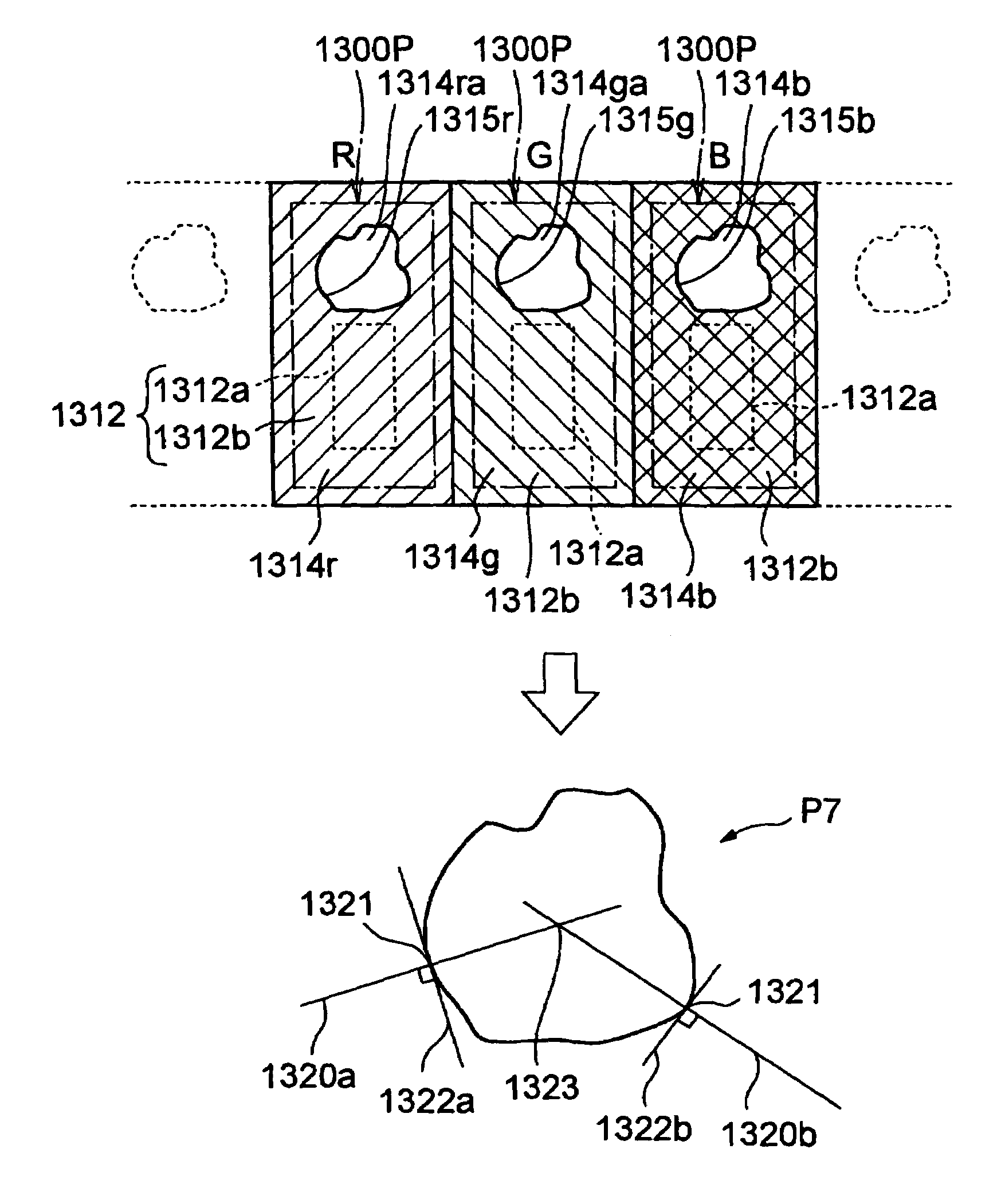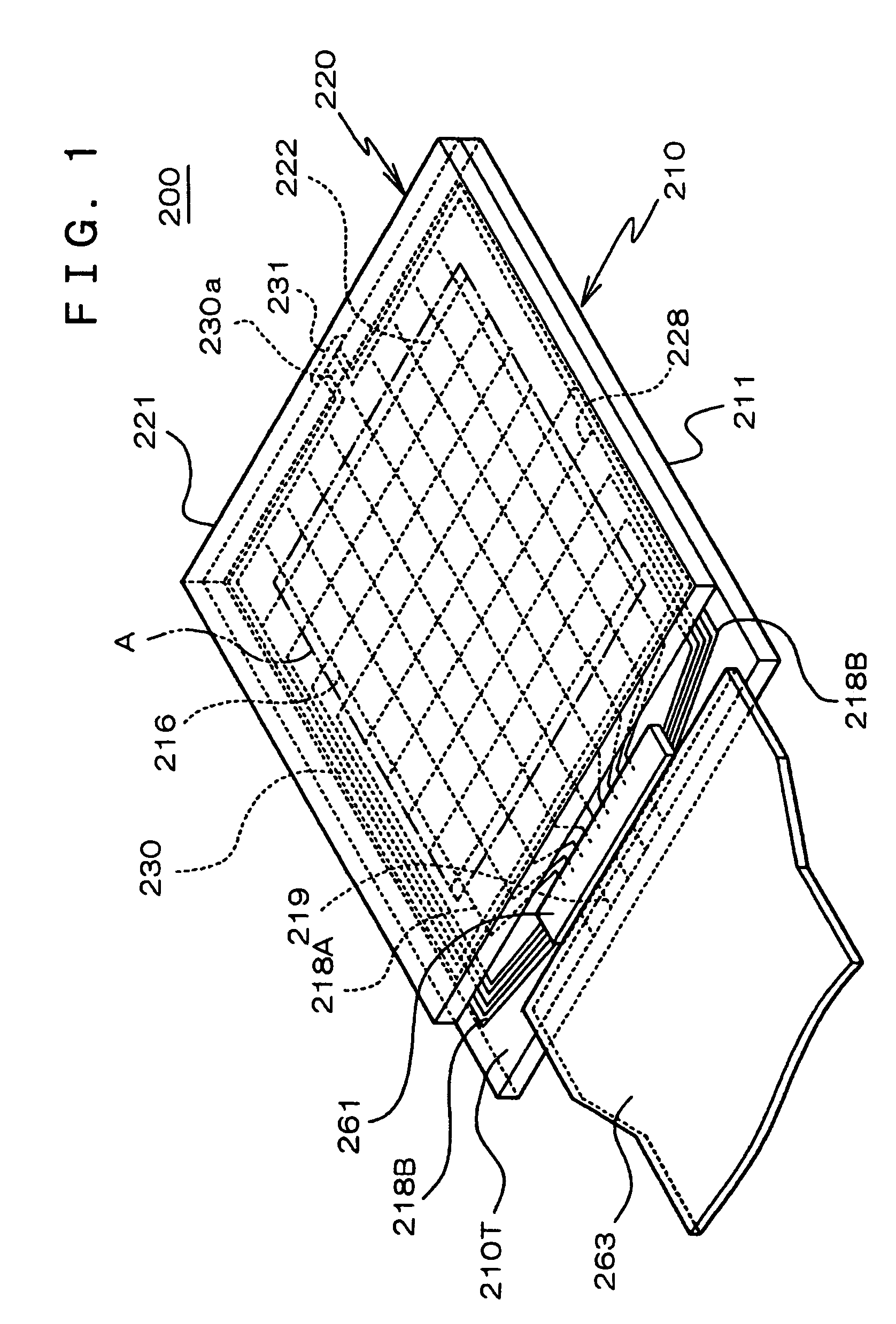Manufacturing method for electrooptic device, electrooptic device, and electronic device
- Summary
- Abstract
- Description
- Claims
- Application Information
AI Technical Summary
Benefits of technology
Problems solved by technology
Method used
Image
Examples
first embodiment
[0075]FIG. 4 illustrates the two-dimensional shapes of colored layers 214 in respective pixels in a first embodiment according to the present invention. In the first embodiment, colored layers 214r, 214g, and 214b, respectively, are formed in a plurality of pixels of R, G, and B. An opening 214ra is formed in the colored layer 214r provided for the R (red) pixel, and an opening 214ga is formed in the colored layer 214g provided for the G (green) pixel. No opening is formed in the colored layer 214b provided for the B (blue) pixel. With these arrangements, a part of the reflecting section 212b of the transflective layer 212 that is two-dimensionally superimposed on the colored layer 214r is not covered with the colored layer 214r, but is in an exposed state. Also, parts of the reflecting section 212b of the transflective layer 212 that is two-dimensionally superimposed on the colored layer 214g is not covered with the colored layer 214g, but are in exposed states.
[0076]The above-desc...
second embodiment
[0081]Next, a second embodiment will be described with reference to FIG. 6. In the second embodiment, an opening 414a having a polygonal two-dimensional shape is provided in a colored layer 414 in a pixel. More specifically, the opening 414a is formed by using a mask pattern P4 having an octagonal two-dimensional shape that is formed by chamfering four corners of a rectangular shape. Here, the mask pattern P4 has eight corners, and the interior angle θ of each of these corners is an angle larger than 90 degrees (i.e., an obtuse angle). Particularly in order to effectively reduce variations in the opening shape and opening area, it is preferable that every interior angle be not less than 110 degrees.
[0082]In this way, using the polygonal mask pattern P4 in which the interior angle θ of each of the corners thereof is an obtuse angle makes it possible to inhibit fluctuations in the opening shape and opening area and increase the reproducibility thereof, as compared with the conventiona...
third embodiment
[0087]Next, a third embodiment according to the present invention will be described with reference to FIG. 8. In the third embodiment, an opening 614ra is formed in a colored layer 614r, an opening 614ga is formed in a colored layer 614g, and an opening 614ba is formed in a colored layer 614b. Each of the 614ra, 614ga, and 614ba is configured to cross a pixel 600P. Specifically, each of the openings 614ra, 614ga, and 614ba is arranged to extend from a portion on the boundary line of the pixel 600P and arrive at another portion of the boundary line. In the illustrated example, pixels each having a substantially square two-dimensional shape are formed, and each of the pixels 600P has four side edges. In this embodiment, each case has an opening formed so as to cross at least two different side edges of the pixel 600P. Therefore, not only the case where the opening crosses the pixel 600P in the right-and-left direction (in FIG. 8) as the illustrated example, but also the case where the...
PUM
 Login to View More
Login to View More Abstract
Description
Claims
Application Information
 Login to View More
Login to View More - R&D
- Intellectual Property
- Life Sciences
- Materials
- Tech Scout
- Unparalleled Data Quality
- Higher Quality Content
- 60% Fewer Hallucinations
Browse by: Latest US Patents, China's latest patents, Technical Efficacy Thesaurus, Application Domain, Technology Topic, Popular Technical Reports.
© 2025 PatSnap. All rights reserved.Legal|Privacy policy|Modern Slavery Act Transparency Statement|Sitemap|About US| Contact US: help@patsnap.com



